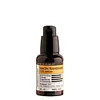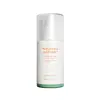What's inside
What's inside
 Key Ingredients
Key Ingredients

 Benefits
Benefits

 Ingredients Side-by-side
Ingredients Side-by-side

Melaleuca Alternifolia Leaf Extract
PerfumingNiacinamide
SmoothingGlycerin
HumectantButylene Glycol
HumectantMethylpropanediol
SolventTranexamic Acid
AstringentWater
Skin Conditioning1,2-Hexanediol
Skin Conditioning3-O-Ethyl Ascorbic Acid
Skin ConditioningGlutathione
Hydrogenated Lecithin
EmulsifyingSodium Hyaluronate
HumectantOcimum Sanctum Leaf Extract
Skin ConditioningCoral Extract
Skin ConditioningAcrylates/C10-30 Alkyl Acrylate Crosspolymer
Emulsion StabilisingPolyglyceryl-10 Laurate
Skin ConditioningEthylhexylglycerin
Skin ConditioningCitrus Iyo Fruit Extract
EmollientNasturtium Officinale Extract
PerfumingTromethamine
BufferingXanthan Gum
EmulsifyingMorus Alba Leaf Extract
Skin ConditioningDisodium EDTA
Morus Alba Flower Extract
Curcuma Longa Root Extract
MaskingMelaleuca Alternifolia Leaf Extract, Niacinamide, Glycerin, Butylene Glycol, Methylpropanediol, Tranexamic Acid, Water, 1,2-Hexanediol, 3-O-Ethyl Ascorbic Acid, Glutathione, Hydrogenated Lecithin, Sodium Hyaluronate, Ocimum Sanctum Leaf Extract, Coral Extract, Acrylates/C10-30 Alkyl Acrylate Crosspolymer, Polyglyceryl-10 Laurate, Ethylhexylglycerin, Citrus Iyo Fruit Extract, Nasturtium Officinale Extract, Tromethamine, Xanthan Gum, Morus Alba Leaf Extract, Disodium EDTA, Morus Alba Flower Extract, Curcuma Longa Root Extract
Water
Skin ConditioningPropanediol
SolventNiacinamide 4%
SmoothingTranexamic Acid 4%
AstringentButylene Glycol
Humectant1,2-Hexanediol
Skin ConditioningPyrus Communis Fruit Extract
Skin ConditioningSodium Polyacryloyldimethyl Taurate
Emulsion StabilisingEthylhexylglycerin
Skin ConditioningPolyglyceryl-10 Laurate
Skin ConditioningMadecassoside
AntioxidantCentella Asiatica Extract
CleansingAsiaticoside
AntioxidantAscorbic Acid
AntioxidantAsiatic Acid
Skin ConditioningMadecassic Acid
Skin ConditioningSodium Ascorbyl Phosphate
AntioxidantWater, Propanediol, Niacinamide 4%, Tranexamic Acid 4%, Butylene Glycol, 1,2-Hexanediol, Pyrus Communis Fruit Extract, Sodium Polyacryloyldimethyl Taurate, Ethylhexylglycerin, Polyglyceryl-10 Laurate, Madecassoside, Centella Asiatica Extract, Asiaticoside, Ascorbic Acid, Asiatic Acid, Madecassic Acid, Sodium Ascorbyl Phosphate
 Reviews
Reviews

Ingredients Explained
These ingredients are found in both products.
Ingredients higher up in an ingredient list are typically present in a larger amount.
1,2-Hexanediol is a synthetic liquid and another multi-functional powerhouse.
It is a:
- Humectant, drawing moisture into the skin
- Emollient, helping to soften skin
- Solvent, dispersing and stabilizing formulas
- Preservative booster, enhancing the antimicrobial activity of other preservatives
Butylene Glycol (or BG) is used within cosmetic products for a few different reasons:
Overall, Butylene Glycol is a safe and well-rounded ingredient that works well with other ingredients.
Though this ingredient works well with most skin types, some people with sensitive skin may experience a reaction such as allergic rashes, closed comedones, or itchiness.
Learn more about Butylene GlycolEthylhexylglycerin (we can't pronounce this either) is commonly used as a preservative and skin softener. It is derived from glyceryl.
You might see Ethylhexylglycerin often paired with other preservatives such as phenoxyethanol. Ethylhexylglycerin has been found to increase the effectiveness of these other preservatives.
Niacinamide is a multitasking form of vitamin B3 that strengthens the skin barrier, reduces pores and dark spots, regulates oil, and improves signs of aging.
And the best part? It's gentle and well-tolerated by most skin types, including sensitive and reactive skin.
You might have heard of "niacin flush", or the reddening of skin that causes itchiness. Niacinamide has not been found to cause this.
In very rare cases, some individuals may not be able to tolerate niacinamide at all or experience an allergic reaction to it.
If you are experiencing flaking, irritation, and dryness with this ingredient, be sure to double check all your products as this ingredient can be found in all categories of skincare.
When incorporating niacinamide into your routine, look out for concentration amounts. Typically, 5% niacinamide provides benefits such as fading dark spots. However, if you have sensitive skin, it is better to begin with a smaller concentration.
When you apply niacinamide to your skin, your body converts it into nicotinamide adenine dinucleotide (NAD). NAD is an essential coenzyme that is already found in your cells as "fuel" and powers countless biological processes.
In your skin, NAD helps repair cell damage, produce new healthy cells, support collagen production, strengthen the skin barrier, and fight environmental stressors (like UV and pollution).
Our natural NAD levels start to decline with age, leading to slower skin repair, visible aging, and a weaker skin barrier. By providing your skin niacinamide, you're recharging your skin's NAD levels. This leads to stronger, healthier, and younger looking skin.
Another name for vitamin B3 is nicotinamide. This vitamin is water-soluble and our bodies don't store it. We obtain Vitamin B3 from either food or skincare. Meat, fish, wheat, yeast, and leafy greens contain vitamin B3.
The type of niacinamide used in skincare is synthetically created.
Learn more about NiacinamidePolyglyceryl-10 Laurate is an ester of lauric acid and Polyglycerin-10.
Polyglyceryl-10 Laurate is a cleansing agent and emulsifier. It helps gather dirt, oil, and other pollutants to be rinsed away. As an emulsifier, it helps prevent ingredients from separating, such as oil and water.
Polyglyceryl-10 Laurate may not be fungal acne safe.
Learn more about Polyglyceryl-10 LaurateTranexamic Acid is best used for treating hyperpigmentation, discoloration, and melasma. It can also help build a stronger skin barrier.
Once applied, Tranexamic Acid starts decreasing inflammation from UV exposure. Tranexamic Acid also prevents our skin cells from meeting the pigment production cells.
Its brightening property makes it great at reducing the appearance of acne scars and marks.
Fun fact: Tranexamic Acid is also a medication used to reduce heavy bleeding.
This acid is derived from lysine, an amino acid.
Learn more about Tranexamic AcidWater. It's the most common cosmetic ingredient of all. You'll usually see it at the top of ingredient lists, meaning that it makes up the largest part of the product.
So why is it so popular? Water most often acts as a solvent - this means that it helps dissolve other ingredients into the formulation.
You'll also recognize water as that liquid we all need to stay alive. If you see this, drink a glass of water. Stay hydrated!
Learn more about Water